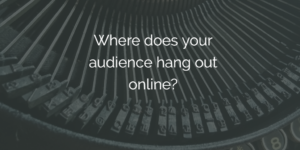Do you publish? If so, where?
The folks at Atomic Reach asked me to be the guest on a Twitter chat about publishing platforms to grow your business. Because I had to pull together some ideas on the topic, I thought I’d share them with you here.
That fact that more and more of us are publishers tells you how much the business landscape has shifted in the past decade. From the advent of easy-to-use, self-hosted blogging software to the rise of digital media, our ability to control what we say and where we say it is radically different today. We no longer talk about whether to publish–we talk about where to get enough quality content to feed the publishing funnel.
I had a column.
Then I had a blog. (Well, I still have that.)
And now I put out content via several social media platforms. But I’ve barely dipped my toe into the LinkedIn publishing stream and my Medium publishing plans keep getting pushed back by more urgent business priorities. But I’ve been thinking a lot about the “hub and spokes” model, and how what your home hub needs to do has changed.
Your home hub (i.e., your Web site) still matters, because you have to have content that informs, educates, and moves your customers toward action. But, at the same time, the home hub is dead. There’s more competition for eyeballs. I’d rather people find me on LinkedIn, Facebook, Twitter, Medium, and so forth, than not find me at all. So where it used to be about pulling people to your blog, now it’s about putting your content in front of people where they are.
Here are a few additional thoughts on this topic.
Picking a publishing platform.

What are your goals and where does your audience hang out online? There’s no building original content for Facebook Instant Articles if your audience is primarily on LinkedIn. In thinking through where to publish, it’s also important to have something else to say. For example, I wrote a business column to expand my audience and reach a wider prospect pool. You also have to identify a separate strategy for each platform. You can repurpose content, but repurpose with purpose.
Publishing platform options.

External publishing platforms can be a good way to extend your reach, your voice, and your brand–and to meet people where they are. One obvious example is LinkedIn. This is a do-as-I-say-not-as-I-do moment, but blogging on LinkedIn can increase your profile visibility. But LinkedIn goes with the person, not the brand, so your brand strategy for LinkedIn has to be a bit more nuanced.
Medium, meanwhile, fascinates me. It’s rapidly becoming a platform for “corollary” thinking and for seeding ideas. For example, Facebook engineers used it to discuss the evolution of their platform’s “like” buttons. This opened a conversation about their brand while informing and extending the conversation beyond the Facebook walls. I want to use Medium to talk about labor relations. It’s part of my expertise, but not the right fit for this blog.
By the way, don’t sleep on YouTube (videoblogging), Tumblr (photoblogging), Medium, etc. It all goes back to the central question: where is your audience?
Three mistakes to avoid when distributing your content across platforms.

The biggest mistake I see organizations make is adopting a one-size-fits-all approach. It never works. You have to tailor your content to the different channels. The second mistake is publishing content that is not relevant to your brand, your audience, or that platform. Think, for example, about the difference between Snapchat and Medium and LinkedIn. The third mistake is not being present. If you post it, they will not come–unless you are part of the community.
Who’s doing this stuff well?
Frankly, most brands are still trying to wrap their brains around the idea of content–let alone where else they might publish their own content. Digital publishers (e.g., Buzzfeed, ESPN) are leading the pack. I’m watching how they create unique content for different channels and taking lots of notes.



